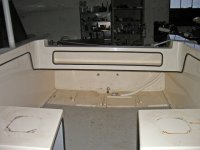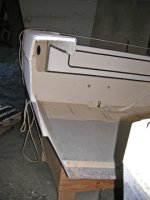John,
Your are absolutely correct. Beefing up this would most likely mean removing the rivets, laying more layers of glass and epoxy between the pan and gunnel, maybe stiffening up under the gunnel, either with glass or a core material--if is actually the gunnel which is flexing, rather than the attatchement of the liner. One could not tell without looking at the area under load--putting at least a couple of big guys on the gunnel, then on the floor, seeing if by leverage you can move the area which is stressed.
As for "repair" of stress cracks--if they are just surface cracks, due to too thick gel coat--which I doubt in this case--but not having inspected it I cannot be sure.--each crack needs to be "V" ground out with a dremmel tool, or all of the gel coat ground down and the entire area re gel coated.
This is not a simple spray on some more gel coat--if you do this, the stress cracks will recurr.
Getting back to Dr John's comment--If I found that there was flexion, I would put wet glass/epoxy between the liner and down turned lip of the gunnel and then clamp the joint until the epoxy hardened--then the load is evenly distributed. Pop rivets are only for very light loads--although I realize that some builders actaully put the hull to deck together that way, it is most likely to fail--and there had many examples of this type of failure.
In fact to take John's thoughts a bit further, one reallly does not want to use rivets where there are heavy loads--if you are tying two non load bearing fiberglass extrusions, that is a possiable use--like a cover over a pannel.


